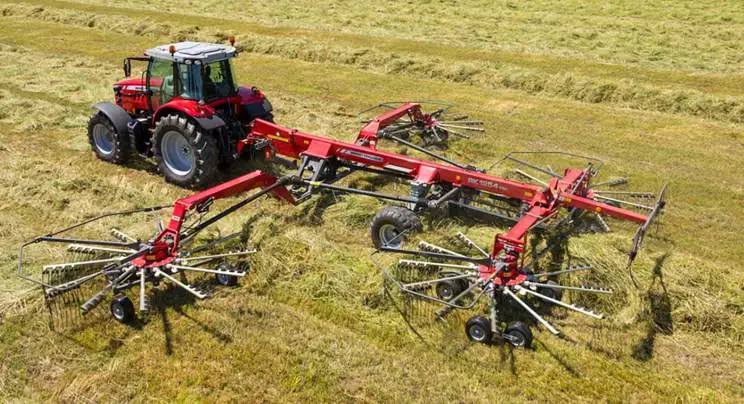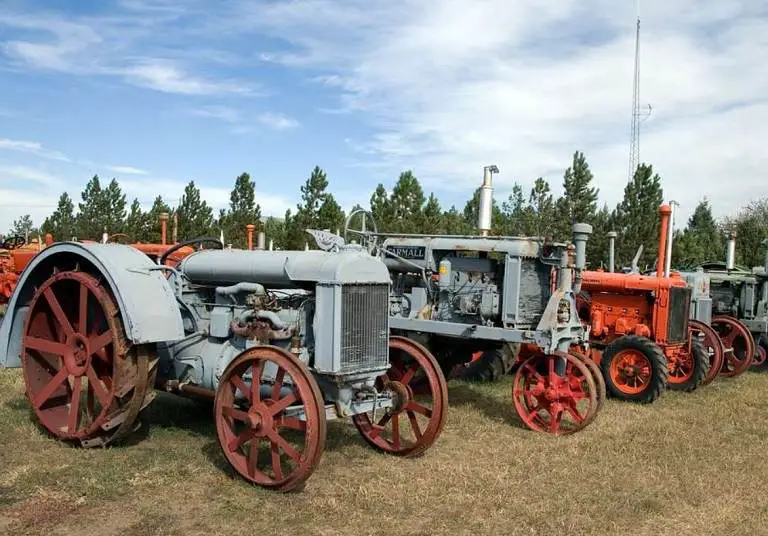No products in the cart.
Tractor
10 Different Types Of Tractors With Pictures
In agriculture, tractors are not merely used to prepare the soil for plantation. Different types of tractors are engineered to serve the specific needs and demands of farmers.
So how many types of tractors are on the market, and how to classify them? Let’s have a detailed explanation of tractors types and their functionalities in this article.
*This post may have affiliate links, which means I may receive commissions if you choose to purchase through links I provide (at no extra cost to you). As an Amazon Associate I earn from qualifying purchases. Please read my disclaimer for additional details.
Different Types Of Tractors
Tractors are divided into 10 types based on their purposes and functions.
1. Utility Tractors

Utility tractors are often used in plowing or pulling heavy attachments like harvesters, tillers, cutters, threshers, etc. These compact machines are the best choice for new or low-budget farmers to do general farming tasks without purchasing additional appliances.
A utility tractor has a horsepower ranging from 45HP to 140HP. It features a low to medium-type engine running on gasoline or diesel. John Deere – a worldwide well-known tractor manufacturer, has a wide selection of utility tractors with horsepower ranging from 80-115 HP.
2. Row Crop Tractor

Row crop tractors can perform many agricultural tasks related to growing and cultivating your crops in rows, including weed control, plowing, leveling, pulling seed drills, and harrowing. They can serve as an alternative to some machines like threshers or water pumps.
These tractors have many advantages, like user-friendly, comfortable driving experience, sufficient row spacing, ease of steering, easy attachment assembly/detachment, etc.
If you need to do a heavy-lifting or lowering an implement, this vehicle can also assist you well.
3. Orchard Tractors

Orchard tractors are specially adapted for various types of orchards or vineries.
First, these small tractors have a remarkable height and a small width with nothing protruding from them. Inside the vehicle, there is an enclosed operator’s seat so you can sit on it to pick fruits, trim tree branches, or maneuver the machine.
Second, their wheels are covered with a shield or a protection layer to keep them protected from thorns found on some fruit trees.
4. Industrial Tractor

Although industrial tractors (previously called Tuggers) are a type of tractor for the construction industry, this tractor type can be utilized in agriculture to pull heavy loads or lift heavy weights when attached to a crane.
Unlike farming tractors, industrial tractors feature a drawbar instead of a three-point linkage. They are available in various models with different horsepower strengths.
5. Garden Tractors

Although garden tractors have a wide horsepower variety ranging from 1 HP to 20HP, they can fit super small construction sizes.
These tractors are often used to cut grass or plant new flower beds in your garden. Garden tractors have wheels with the size of your scooter that are much thicker.
Nowadays, more than 100 different designs and models of garden tractors are available on the market, with the price from under $2,000 to over $4,000. Since this tractor type is diverse in size, capability, and price, you will have a more extended garden tractor that fits your requirements.
6. Rotary Tillers

Rotary tillers are walking-type tractors, primarily used in small-sized fields or fields at different height levels, where ordinary tractors can work efficiently. This special tractor type is compact enough to fit into small areas and over hills with no difficulty.
Rotary tillers feature blades to set seedbeds on the farm. The rotating blade can handle even hard or chunky soil and turn it into a fine, clod-free bed ready for planting.
In addition, you can adjust the tiller’s working depth by adjusting the skid shoes.
7. Implement Carrier

Implement carrier tractors often take part in the carrying and mounting jobs for many types of attachments (or implements). These tractors have an extended chassis frame between the front and rear tires, allowing them to mount different tools, such as sprayers, loaders, rotary sweepers, seed drills, dusters, etc.
Since there are many models of carrier tractors with different sizes and designs, you should discuss with the dealer to get the right tractor for you.
8. Earth Moving Tractors

Earth-moving tractors are heavy-duty and robust, coming with both tires and track types. These vehicles can be your lifesavers if you are working on dams and quarries on a construction site. They are relatively expensive but are often made to last with sturdy construction.
Earth-moving tractors are often used to relocate and move heavy materials like mud, lumber, dust, rocks, debris, etc. Besides, they can also move earth to dig holes for basements or new construction.
There are three types of earth-moving tractors:
- Bulldozers (or crawlers): these machines feature large plates at the front to push rocks, dirt, or clear an area. Their complete tracks help them maintain their stability when moving on all types of terrains.
- Excavators: these machines are not only used for digging and demolishing jobs. They have a long bucket arm to lift heavy implements and shovel dirt. Thanks to their elevated seats, drivers can get a broad view of everything outside.
- Backhoe loaders: these machines are utilized for many farming tasks, from digging holes to breaking asphalt. Depending on your demands, you can adjust their buckets in the back and shovels in the front.
9. Military Tractors

Military tractors (or artillery tractors) are often used by the militaries since the 1970s to move heavyweight military implements. Nowadays, they are used to perform jobs in risky areas, like construction, demolition, temporary road building.
Military tractors have the same design as industrial tractors, and they move on tracks, wheels, or semi-tracks. Their rock-hard frames and undercarriages allow them to tolerate landmines and explosive devices. In this tractor category, there are also some amphibious or semi-amphibious tractors.
10. Driverless tractors

Driverless tractors (or called autonomous tractors, electric tractors) use artificial intelligence in their operation. In the future, they can be developed to handle many agricultural or industrial jobs.
Driverless tractors are controlled using various devices and technologies, including computers, drone technology, GPS, and satellite. Many tractors (maybe a dozen) are controlled by a single operator and with no human interruption.
Other Ways To Classify A Tractor
Not only based on their exact purposes, but you can also classify types of tractors by their types of construction and types of drive.
1. Types of construction
Based on their construction types, tractors are divided into 2 types:
- Type 1: tractors with an operator’s seat, meaning that the farmer can sit inside and maneuver the machine.
- Type 2: these tractors are called “walking-type tractors” because the operator has to walk next to the machine instead of sitting inside it.

2. Types of drive
Based on drive types, tractors are divided into 2 types – track type and wheel type.
Track Type
There are two tractor groups based on their track types – half-track and full-track.

In a full-track tractor (or a track tractor), a track is installed on each side instead of wheels to get drive from the sprocket run by a real axle shaft. You don’t need to use steering gear to steer this tractor. The vehicle is automatically steered by allowing one side of the track to move while applying the brake on the other track.
There is an interesting fact you should know about track tractors. In the 1970s-1980s, heavy wheeled tractors were used as alternatives to tractors with steel tracks due to disadvantages and limitations.

In a half-track tractor, a small track chain is installed at the rear end, provided that tires are attached at the front axle. This tractor is often used on uncultivated lands that are not frequently used for agricultural tasks.
Due to its large contact area with the ground, this machine has a higher traction power than other tractor types. Therefore, it’s helpful in dams or earth-moving tasks.
Wheel Type
There are 3 types of tractors based on their wheel type – two-wheeled (2 wheeler), three-wheeled (3 wheeler), and four-wheeler.
Wheel-type tractors are mainly used in agricultural tasks. They can move fast and smoothly, thanks to their fitted tires’ exceptional shock absorption capability. This tractor type is used for general gardening tasks on smaller farms or hill terrains.
Three-wheel types (or tricycle types): these tractors have now been replaced by four-wheelers. These tractors have a single or dual tire at the front, allowing them to move around shorter turns.
Read More: How to Drive a Tractor Video and Guide. If you’re new to tractors, this beginner’s guide is a great place to start! Learn about safety rules, starting your tractor, and watch a helpful video.
Considerations When Choosing A Tractor
1. Size of your land
Besides knowing the importance of different types of tractors, you should choose a tractor that aligns with the size of your farm. Plus, you should also consider the present and future demands of the tractor within this area.
For example, large-sized farms need a tractor with horsepower from 45-70 HP for tasks like tilling, mowing, spraying, etc. On smaller farms, tractors should have a horsepower of 35 HP to handle basic tasks.
2. Your budget
A tractor is a serious investment that might cost you a remarkable amount of money. You should pick up a tractor, the price tag of which stays within your predefined budget.
Read More: How Much Does a Tractor Cost for Farming? We discuss the price ranges of popular tractor models and the average cost of new and used tractors!
3. Hydraulics
The hydraulic system plays a vital role in the machine’s turning and lifting abilities. The hydraulic liquid transmits energy via the hydraulic system, allowing a tractor to move and tackle various farming jobs.
Before making a final purchase decision, you should ensure that the tractor’s hydraulic system functions normally.
4. Lift capacity
Choosing an appropriate lift capacity in a tractor can be challenging, as there are many specifications in this criterion, like arm lift capacity, static lift capacity, full-height lift capacity, etc.
Since each tractor has a different hydraulic flow and pressure, you should purchase a loader from the same manufacturer with the tractor for compatibility.
5. Transmission
There are 2 transmission types – hydrostatic transmission and mechanical transmission.
Mechanical transmission is more energy-efficient than hydrostatic transmission. However, the hydrostatic transmission allows you to choose any engine or ground speed ranging from zero to the maximum. Therefore, it’s more flexible in operation than the remaining one.
Read More: What Are ROPS On a Tractor? ROPS keeps you safe while operating your tractor. This guide discusses ROPS and why they’re important features.
Final Words
Tractors are fantastic machinery that can be used for numerous farming and construction tasks, provided that you pick up the right one for the right jobs. After knowing different types of tractors in use worldwide and how to classify them, you are more confident of picking up a tractor that best suits your daily farm operation demands.

